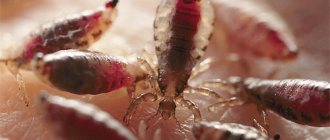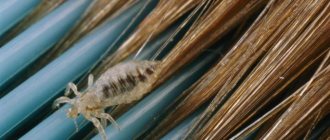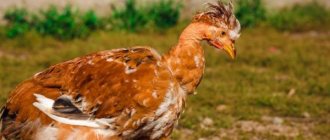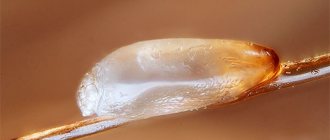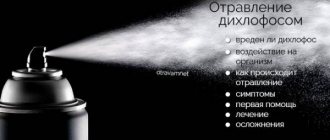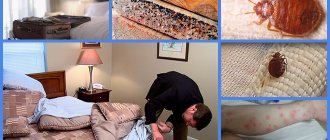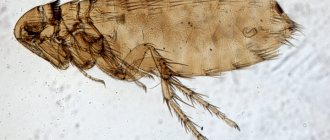What do linen (body) lice look like?
The appearance is not much different from other types of lice. These are insects 3 – 3.5 mm long, some individuals reach 5 mm. They have a flattened, elongated body of a light brown color. When saturated with blood, they darken and increase in size. The parasite has three pairs of legs, their shape and structure are slightly different from the legs of head or pubic lice. During its development, the body louse has adapted to move mostly not along hairs, but along clothes, linen and skin. Because of this, the legs of body lice are less tenacious than those of other species.
The mouthparts are equipped with sharp stilettos, which they use to pierce the skin. The blood is sucked out using the proboscis. They are also injected with a substance that prevents the blood from clotting. Because of this location, linen lice bites most often result in bruising.
The eggs of linen lice are the same as those of head lice. They are round, white, 1 - 1.5 mm in size. Usually females lay them in a heap, in one place. The clutch can be noticed precisely because of the large number, since the nits themselves are very small.
How to quickly get rid of linen lice at home yourself
Dealing with parasites, especially if their numbers are small, is not difficult.
Linen on which lice have infested, after treatment with an insecticidal agent, should be boiled , then dried in a well-ventilated place, and then thoroughly ironed with a hot iron (it is more effective to use a steam generator).
ATTENTION! Regular washing cannot kill linen lice. Eggs remain viable at a temperature of 60 0C
If for some reason you do not have the opportunity to wash and disinfect your clothes, put them in a sealed bag, close them well and leave them for 2.5 weeks. This time is enough for the insects to die.
IMPORTANT! The more parasites, the harder it is to get rid of them. If there are few lice, a single application of measures aimed at exterminating the insects is sufficient.
If the air temperature is above 40 0C or below 5 0C, then the activity of adults decreases : females stop laying eggs, therefore new lice do not hatch. To completely destroy lice, you can use the freezing method (things are hung out in severe frost or placed in a chamber for quick freezing of food).
Life cycle
This parasite goes through several stages in its development:
- nit – an egg in which a larva develops; development occurs within 5–8 days;
- nymph of the first, second and third order - the larva emerges from the egg and goes through three molts, increasing in size; this stage usually takes from 16 to 21 days;
- imago - an adult individual.
Body lice begin to bite and drink blood already at the nymph stage, but only adult insects can mate and reproduce. The female lays an average of 4 eggs per day. Over the course of its life, it lays more than a hundred nits, so lice must be dealt with immediately after detection in order to prevent a sharp increase in the population. There are also particularly fertile individuals that can lay up to 300 eggs in their lifetime.
Living conditions
A louse lives 30–40 days. To live and reproduce, it needs to have access to a food source. The parasite feeds up to 6 times a day.
The decisive factor determining life expectancy is air temperature. The most comfortable temperature is 31 degrees. It is under these conditions that all types of lice live and reproduce. When it drops to 20 degrees, the louse stops reproducing; when it gets colder, it goes into suspended animation and dies after a couple of days. High temperatures of more than 40 degrees are also detrimental to the parasite.
Lice can survive in high humidity. They are not even afraid of water and can stay in it without risking their lives for some time. Drought is more destructive for them.
Lifestyle
Linen lice spend most of their lives outside the human body. They lay eggs in linens and clothes. They're hiding there. Where can you find body lice:
- bed linen and accessories - pillows, blankets;
- mattresses;
- cushioned furniture;
- towels;
- clothing, including on a person or folded in a closet;
- carpets, curtains and other home textiles.
Any soft things that retain heat can become a haven for insects. They can be found on the back walls of cabinet furniture, paintings, and under wallpaper. They do not penetrate deeply into upholstered furniture, like bedbugs, but they are quite comfortable under the upholstery.
Bed lice live in clothing and other textiles, but they need food to live. The source of food is man. Lice must be near a person to access their blood several times a day. This insect can go without food for up to two days, but under normal conditions it feeds every 4 hours.
Linen lice do not jump or fly, but they can move very quickly across surfaces. In half an hour, the insect will cover a distance of up to 50 cm. They try not to live at a greater distance from a person. That is why they usually live in bed, because there the access to human blood is most convenient and quick.
What do linen lice look like: photos of bites
Externally, linen lice are quite similar to head lice; as emphasized earlier in the article, linen lice themselves are ordinary evolved head lice. Their length is in the range of 2−5 mm, they do not have wings, and have an elongated abdomen. At the edges of their abdomen they have peculiar folds, which are necessary for parasites to free themselves from a portion of food.
One of the main differences between linen lice and head lice is the color of their abdomen; usually linen lice have a lighter abdomen than head lice. But this only applies to the so-called hungry lice; after the linen louse is saturated with blood, its abdomen changes its color and becomes dark, often blood-dark in color.
There are practically no differences between the larvae and the linen lice themselves; purely outwardly, they look exactly the same, differing only in their size; as you might guess, the larvae are noticeably smaller in size than adults.
Photos of bed and body lice bites:
The nits (eggs) that linen lice lay are exactly the same in appearance as the nits of head lice. Most often, the female linen louse lays eggs between the seams of clothing and in other places where it is especially difficult to reach them. The nit is very small in size, about 0.5 mm, so it is almost impossible to find a louse egg on clothing or bedding without a magnifying glass.
As has already been noted, it is quite difficult to notice lice on clothing, however, there is a feature that can give them away. Very often, linen lice prefer to stay in groups, especially in places on clothing that are convenient for them.
If it is quite difficult to notice lice individually, then it is much easier to notice a group of them.
As for the food of linen lice, they eat only blood, for sucking it they have special devices with which they pierce the human skin, and also inject special enzymes into the blood, which leads to a deterioration in its coagulability, then they simply suck out what is needed for yourself the amount of blood. The average individual feeds in this way about 4-5 times a day.
Linen lice are quite hardy, they are able to survive at temperatures of 0 - 45 degrees Celsius, the most optimal temperature for them is 31-32 degrees, at this temperature they reproduce best. In the event of a sharp drop in temperature to zero, their physical activity can be quite significantly inhibited, and become more active again when the temperature rises.
The main symptoms of linen lice are the unexplained appearance of small red spots on the body and severe itching in these places. If there are such signs, it is worth checking your household linens.
What does the initial stage of toenail and fingernail fungus look like, and how to treat it?
You can read more about the prevention and treatment of helminthiasis in children.
Lichen versicolor in humans is described here: https://parazity-gribok.ru/fungus/lichen/prichiny-porazheniya-cheloveka-otrubevidnym-lishaem.html.
How dangerous are bed lice?
Like all other blood-sucking parasites, linen lice can be carriers of diseases. They can live on more than one person, which means that when they bite, they carry pathogens on their mouthparts. When they bite, they inject these blood particles and thus spread infections. It is linen lice that spread typhoid fever, relapsing fever and other infectious diseases.
In addition, the bites of linen lice themselves pose a health hazard. As already mentioned, when they bite, so that the blood does not clot immediately, they inject special active substances under the skin that can cause severe allergic reactions.
In addition, lice bites are irritating and cause unbearable itching. A person constantly scratches the affected areas, which do not heal for a long time and can become re-infected. This leads to dermatitis, skin and infectious diseases, fever and even blood poisoning.
When infested with linen lice, pediculosis is diagnosed. This is a disease that needs to be fought. It doesn't go away on its own.
What does a linen lice look like (photo)
What do linen lice look like, which are usually seen next to furniture? The linen louse is a small insect, only 2-3 mm, there are no wings, the abdomen is elongated. Under a microscope, you can see the folds near the insect’s abdomen; when the louse is full, they smooth out. What distinguishes linen lice from head lice is that, unlike their counterparts, they are lighter, almost white, and after a heavy “lunch” they acquire a brown or red color. Of course, this is not the only difference that allows you to determine what linen lice look like. Entomological specialists know much more. And as already mentioned, they do not have devices on their paws to hold onto hair. In practice, it is very difficult for a non-specialist to distinguish between them. What do linen lice look like on the human body? See below.
Linen lice larvae are smaller copies of adult insects. And their nits are practically indistinguishable from the nits of their head counterparts, only they are found in places where it is very difficult for a person to reach, for example, in the seams of fabric, on folds, in various folds. And it is very difficult to see nits with the naked eye.
If you come across a group of small insects sitting in the folds of your laundry, most likely these are linen lice. They crawl out to feast on blood alone, but prefer to spend time (mating, resting, laying eggs) in company in the folds of clothing.
Lice feed only on human blood, using special growths in the oral apparatus. They also inject special enzymes that cause allergies to bites and even blue spots on the bitten areas. There are many similarities with bedbugs, but they are still not bedbugs. What do linen lice look like when there are a lot of them in your apartment?
The movement speed of body lice is up to 30 centimeters per minute; with a high number of insects, they spread throughout the apartment, onto the bed and various furniture.
Insects live a little more than a month. During this time, the female lays up to 140 eggs (nits), after about five days, provided that clothing is worn on the human body, the insect hatches. If the temperature changes, the full incubation period can last up to two months. It should be noted that environmental factors such as temperature and humidity do not affect the appearance of linen lice. Rather, on their ability to survive, but not on how they look.
The favorite habitat of lice is dirty clothes, unsanitary conditions, and stale things. However, perhaps, if you read these terms, you can rightly be indignant: how can this be, if we regularly wash our clothes, clean our houses, but there are never any things left behind? It’s just that not everything is so simple, and despite the fact that it would seem that linen lice are just lice, they also “want” to survive, no matter what conditions they find themselves in.
How to get rid of linen lice
When bed lice are detected, comprehensive control is necessary. You need to get rid of insects and nits that can be on the human body and on his things. If parasites are found in one of the family members, not only him, but all of them will have to be treated.
Firstly
It is necessary to destroy insects on clothes. To do this, it must be washed at temperatures above 40 degrees. To be on the safe side, you can pre-soak things in a pediculicide solution. After washing, you need to dry the clothes well, you can do it in the scorching sun or, conversely, in the cold. Then you should iron your clothes and linen on both sides with an iron. It is good to use a steam generator for processing.
If items cannot be washed in the usual way, they can be dry cleaned. If they are not subject to any processing at all, you need to put them in a sealed plastic bag and leave them there for 2 or 3 weeks. During this time, the parasites will die due to lack of food. Eggs laid during this time will not be able to develop and will die. After such imprisonment, the item must be thoroughly cleaned to remove insects, nits and traces of their presence.
You can also use the temperature method. For example, pillows, blankets, rugs can be taken out into the scorching sun or bitter cold. This is a folk method that does not lose its relevance. But things must be subjected to heat treatment for several hours.
Secondly
All furniture needs to be treated. For cleaning, you should use a steam generator or call special services that use professional cleaning products. Steam treatment is effective because it penetrates the entire thickness of the furniture and destroys insects that are deep under the upholstery.
Any home textiles and cabinet furniture should be treated with pediculicides. We recommend using preparations for the destruction of lice produced by MediLIS Laboratory LLC. All of them are effective against insects and nits, for the destruction of which one treatment is enough. There are preparations that can even be used to treat children over 5 years of age and their belongings.
Also, with insecticide solutions, you need to wash all floors and any surfaces in the room on which adult lice or eggs may remain.
Third
It is necessary to process all people living in this room.
Despite the fact that body lice do not live on the human body, they can hide in hair, and nits can be found under skin flakes. On a person, a linen louse can survive difficult times, after which it will move to more comfortable conditions, where it will continue to live and reproduce. To ensure that you get rid of lice, you need to thoroughly wash your body and hair with pediculicidal products. To be on the safe side, comb your hair with a fine-toothed comb. That is, carry out the same treatment that is carried out when fighting head lice. Considering that the incubation period for nits is 5–8 days, after a couple of weeks it is worth carefully inspecting the room, clothes and underwear to detect new individuals. Due to the small size of the eggs and their ability to survive difficult times in a state of suspended animation, it may turn out that even complex treatment does not destroy absolutely all nits. Therefore, additional checking and processing will not hurt.
How to get rid of linen lice at home?
Lice feed on human blood and, as a rule, do not parasitize domestic animals. A louse can live for a long time without food (about 10 days), but nevertheless, these parasites almost always try to be closer to the food object. One of the ways to effectively combat such lice is to completely exclude access to their food source . It is quite enough to simply pack any lice-infested clothing in a sealed bag without air and leave it like that for a couple of weeks.
- Clothing and linen should be steamed and the seams additionally ironed.
- Do wet cleaning regularly.
- It is also recommended to wash carpets, curtains, blankets and rugs and expose them to high temperatures.
- Treat seams on furniture, pillows, mattresses with hot steam or a hair dryer.
Along with cleaning, you can use a 0.15% solution of karbofos and wipe the perimeter of the room, around beds and cabinets. In order not to confuse the proportion, weigh 5 grams of 30 percent Karbofos, or 3 grams of 50 percent concentrate and dilute the product in 1 liter of water.
The procedure must be performed everywhere, under carpets and on walls, all chairs. tables must be processed from above and below. Be extremely careful, don't miss anything. It is recommended to treat the entire apartment to prevent insect migration.
Chemicals
Probably the most effective preparations for linen lice at present are products that essentially contain organophosphorus compounds. These substances include, for example, chlorpyrifos or karbofos. This also includes dichlorvos, which was extremely popular in its time. It is only important to know that dichlorvos in our time has for quite some time now had nothing in common with the Soviet drug of the same name . Modern dichlorvos of various brands uses insecticides from the pyrethroid category that are safer for human health.
The organophosphate insecticides described above are considered quite toxic to humans . In addition, they often cause various irritations when they come into contact with the skin, so they are rarely used against lice. True, sometimes karbofos is still used to eliminate annoying linen lice and nits in the composition, for example, of the following products:
- Aerosol Para-Plus - karbofos is included here along with insecticides called piperonyl butoxide and permethrin. All three substances have a full-fledged neuroparalytic effect on bloodsuckers, but only karbofos is able to penetrate through the special shell of the nit directly into the body of the larva developing there. The aerosol must be applied to the hair and scalp, straightening the hair with your fingers. Then the drug must be left for 10 minutes and then washed off with plain water.
- Pedilin shampoo is based exclusively on karbofos and is slightly easier to use than Para-Plus. The drug is applied to the hair and left for almost 20 minutes, then washed off. The insecticide kills not only linen lice, but also most nits.
Both Pedilin and Para-Plus can not only eliminate lice, but also lead to the development of various side effects in humans. Fortunately, karbofos in these drugs does not pose any danger to human nerves, since it is quickly neutralized and eliminated from the body. Insects do not produce such neutralizing substances. However, both drugs can cause skin irritation and cause allergies. Read the instructions on the packages carefully.
Linen lice, how to get rid of them using folk remedies?
If chemistry is not suitable for you for some reason, then you can try folk remedies, but the result is not guaranteed . Many of them are very good because they are equally dangerous for both adult parasites and their eggs. The main disadvantage of many traditional methods is their danger if used incorrectly. Eg:
- Using kerosene, hydrogen peroxide, and vinegar, you can practically burn out bloodsuckers. But when used, there is always a high probability of getting a full-fledged burn , much more dangerous than the bloodsuckers themselves. Modern hydrogen peroxide also bleaches human hair well: it is almost impossible to eliminate head lice with its help without changing the overall hair color. Regarding the use of kerosene, there have been terrible incidents of children catching fire on their heads when working near an open flame. The results are also quite disastrous if ignorant parents incorrectly dilute the essence of vinegar and then treat their children’s hair with this solution.
- Cranberry juice weakens the attachment of nits to the hair, but, unfortunately, it cannot kill them completely. It is effective to combine this product with special combs for thoroughly combing out parasites.
- Hellebore water is toxic to nits and lice. Probably, it can be considered one of the best folk remedies against linen lice. If you carefully ensure that such liquid does not get into your nose, mouth or eyes, it will not cause any harm.
- Remedies such as essential oils, as well as herbal decoctions against linen lice and, especially, against nits are practically ineffective. These substances simply repel bloodsuckers, but if the parasites simply have nowhere to go, they will definitely survive such treatment.
Now you know what linen lice are and how to get rid of them. It's simple, isn't it? There is a faster way with a guaranteed result - call our specialists . They will come, process and fill out the necessary paperwork.
Prevention
Bed lice are more difficult to catch than head lice. To do this, you need to come into contact with the personal belongings of the sick person. These parasites have become widespread among people with low social responsibility. Failure to maintain personal hygiene and cleanliness of personal items leads to the development of insect populations. If you don't fight them, their number increases exponentially.
Most often, linen lice are found in people without a fixed place of residence who do not have the opportunity to wash themselves and wash their clothes. Also, body lice can occur in places with a large concentration of people without constant access to sanitary facilities. These are prisons, hospitals, long-distance trains. Oddly enough, these parasites are also found in children's educational institutions.
If there is a suspicion of infestation with linen lice, preventive measures must be taken immediately. Wash clothes and linens at 40 degrees or more, iron them or treat them with a steam generator, treat furniture and other surfaces with insecticides, wash your body and hair with special anti-insect preparations. It is better to take unnecessary precautions than to allow the development of head lice, which will then have to be treated for a long time.

